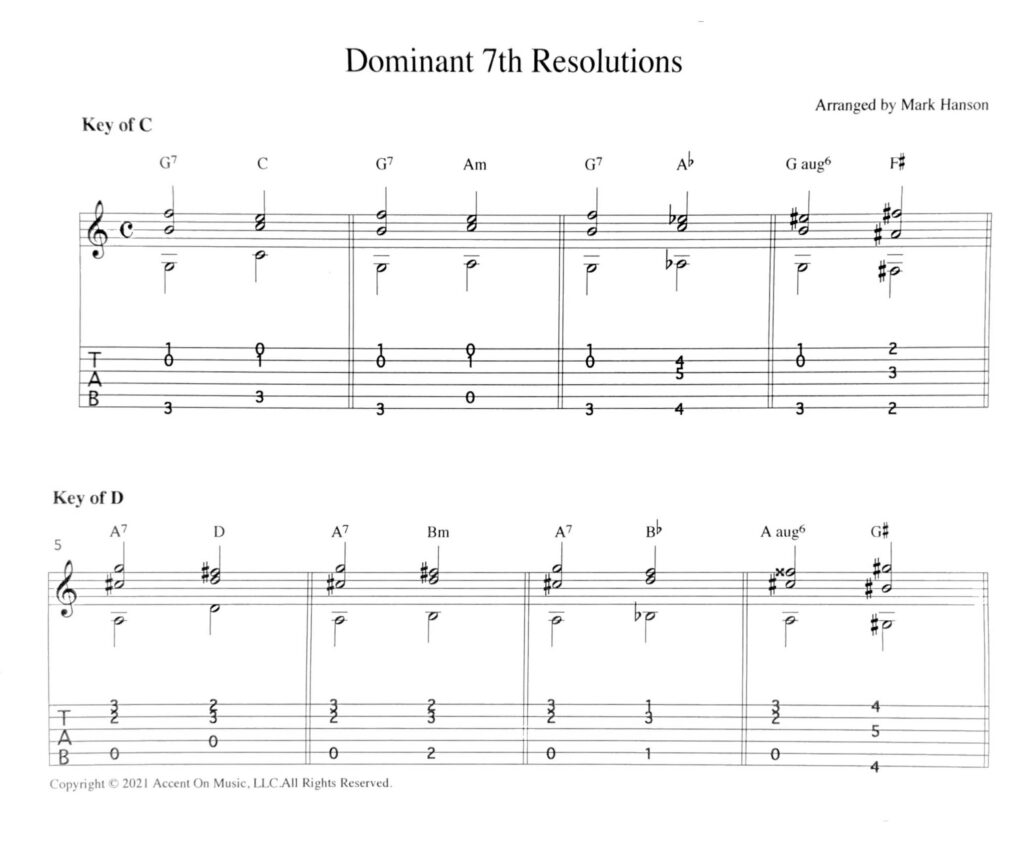By Mark Hanson
It was fun to read about Sting studying scores of French Impressionist composer Maurice Ravel (“Bolero”) for new harmonic and chord progression ideas. In this article we’ll study a chord progression you may not have seen: a dominant 7th chord resolving down 1/2 step (G7 to F#, or D-flat7 to C, for instance) — the “Augmented 6th” progression.
First, here’s a fundamental harmonic movement to understand:
You all know that V7 chords (“dominant 7th”) resolve regularly to the I chord (“tonic”): G7 to C, for instance. They also resolve effectively up to the vi chord of the key (G7-Am), called a “deceptive cadence”; and, similarly deceptively up to the flatVI chord (G7 to A-flat major). All of these progressions contain the “proper” resolution of our tritone interval, the “unstable” (somewhat dissonant) pair of notes — six frets apart — that largely drives Western music.
This “proper” resolution of the tritone allows V7 chords to also effectively resolve down 1/2 step — G7 to F#, for instance, or D-flat7 to C. This is very common in jazz. As I’ve stated, this chord progression is the “Augmented 6th” progression. The Notation/TAB below shows these in two keys.
Before we get to your assignment (!), an explanation of the name “Augmented 6th”: An Augmented 6th chord (1, 3, 5, #6) has the same pitches as a dominant 7th (1, 3, 5, b7) but is spelled differently to adhere to the classical rules of voice leading. It acts and sounds like a dominant 7th, but the b7 note becomes its enharmonic equivalent, the #6. For example, a G augmented 6th chord (a G7 sound) has an E# note in it (G, B, D, E#), not the F of a G7 (G, B, D F)! Same sounds, though!
Why is this of interest to guitarists? Spelling the chords correctly makes not one whit of difference in how you play them or how they sound. But dropping down 1/2 step from a dominant 7th chord is an unusual and ear-catching chord change that you can use effectively.
Here’s your assignment:
Determine and play these progressions in all the CAGED guitar keys. I’ll give you the answers in two of them. The diagram below shows the “proper” resolution of the tritone in the keys of C and D:
Possible “Proper” Resolutions of a “Dominant 7th” chord
V7 – I
V7 – vi
V7 – flatVI
V7 – #IV
In the key of C:
G7 – C
G7 – Am
G7 – A-flat major
G7 – F# (or try D-flat7 to C)
In the key of D:
A7 – D
A7 – Bm
A7 – B-flat major
A7 – G# (or try E-flat7 to D)

“Proper” Resolution, You Ask?
Of course, a G7 chord can go anywhere: B7, A7, F, E7, E-flat7, just to name a few. But these changes do not include the tri-tone resolution. A tri-tone resolution is this: the third and the seventh notes of a V7 chord (B and F of a G7 chord, for instance) resolve towards each other or away from each other to the root note and third (or third and fifth) of the chord you are approaching.
In a G7-C chord progression the B and F notes resolve to C and E (part of a C chord and an Am); or they can resolve to C and E-flat (part of an A-flat chord); or to F# and A# (an F# major chord, the augmented 6th). In the last case, the F is called an E# because in classical music they don’t like notes with the same letter name — but different pitches — resolving to each other. In other words, F notes don’t resolve to F#s — E# notes resolve to F#s! Same sound, I reiterate!
Tritone Substitutions
Jazz cats use this all the time. For example, a D-flat7 can readily substitute for a G7 resolving to C. These two dominant chords share the same tritone, which can resolve “properly” to C. D-flat7 dropping 1/2 step to C is called an augmented sixth progression: D-flat(aug6) to C.
The fact the D-flat and G chords are themselves a tritone apart (6 frets; 1/2 octave) gives D-flat the “tritone substitution” designation for a G7.
Mark Hanson – November 2021
Copyright © 2021 Accent On Music, LLC. All Rights Reserved.
==========

